Runner Prefontaine Was One of a Kind
- Share via
He would no doubt be delighted to know he’s still selling tickets.
Steve Prefontaine has now been dead as long as he lived, 24 years.
When he ran his sports car off a two-lane road in Eugene, Ore., and died, America had lost perhaps its most charismatic track athlete ever.
When he died, he held every American distance running record between 2,000 and 10,000 meters.
He had a compelling, hard-charging running style and a fiercely competitive personality. He was an icon in his sport, wildly popular in the Eugene track community, yet not near his peak as a runner. Track promoters loved him.
Twenty-four years later, Prefontaine movies, books and magazine articles continue, suggesting his popularity has never waned.
At 22, he made a bold bid for a gold medal at the 1972 Olympic Games’ 5,000-meter final before fading in the stretch.
He died hours after winning a 5,000-meter race at the University of Oregon. He had attended a party for Finnish athletes after the meet and had driven his girlfriend home before he ran off the road. The car flipped over and Prefontaine was suffocated by the weight of the car on his chest.
An autopsy showed he was drunk at the time of the accident. He’d often said in interviews that he’d incorporated beer drinking into his training program.
His funeral, attended by thousands, was held in his high school’s stadium at Coos Bay, Ore., where Prefontaine had become a nationally known high school runner.
Said his father, Raymond: “That’s where it all began and that’s where it ends.”
Also on this date: In 1911, Ray Harroun, 39, in the first Indy 500 before 77,000, drove his Marmon Wasp to victory, averaging 74.602 mph. He earned $10,000. A Times headline called it “The Greatest Automobile Contest Ever Held.” . . . In 1956, Mickey Mantle missed by 18 inches clearing Yankee Stadium’s right-field roof. His blast against Pedro Ramos of the Washington Senators hit the facade 115 feet above the playing field, 370 feet from home plate. He hit one in 1963 near the same spot. Years later Mantle said, “The ’63 home run was the hardest ball I ever hit. The 1956 ball was just a high fly by comparison.” . . . In 1977, Dennis Eckersley of the Cleveland Indians pitched a no-hitter in a 1-0 victory over the Angels.
More to Read
Go beyond the scoreboard
Get the latest on L.A.'s teams in the daily Sports Report newsletter.
You may occasionally receive promotional content from the Los Angeles Times.










